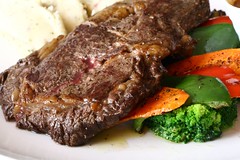How To: Perfect Prime Rib

I'm sitting at my table with a fork, knife and Diet Pepsi, enjoying the best prime rib I've ever eaten. Truth be told, it's the best meat I've ever had, period. I thought I'd share with you the steps it takes to prepare prime rib like the succulent morsel I'm enjoying today:
1. Take the five-pounds of prime rib you received for Christmas out of the freezer. You know? The one you stuffed in the back because you had no idea how to cook?
2. Let thaw for five minutes: one minute per pound of meat.
3. While waiting for meat to thaw, ignite your barbeque grill. You know? The one you have no idea how to light?
*Helpful Hint: don't follow direction on the front of barbeque that says to turn gas, as well as front burner, to High. You may have white flakes fall off your eyebrows if you do.
4. After you've completed steps one through three, look up "can you barbeque prime rib?" to make sure this is something you can do. You will find great tips on many things besides barbequeing prime rib. You will find just enough information to know that, barbequeing prime rib appears to be something people have done before. Through your light reading, you will also notice something that suggests you cook large slabs of meat at 500 degrees. Note this.
5. Once you have done your research, take your thawing prime rib out to the grill, along with the exciting spices you've selected to flavor your meat: iodized salt, Lawry's Seasoned Salt, and McCormick pepper.
6. Your grill should be ready. The thermometer on the face of your grill should read 500 degrees.
*Helpful Hint: Your grill may be old and produce inconsistent flame. If this is the case, place your icy prime rib on the fieriest place on the grill.
7. Salt and pepper to taste.
8. This is the easy part. You wait. You may have other preparations to make for your meal. If you do, now is the time.
9. In ten minutes or so, you will want to flip your meat.
*Helpful Hint: You may want to use a flame-resistant utensil, as the grill will be extremely hot and the five pounds of meat will be heavy to lift with a plastic pancake flipper.
10. For that delicious char-grilled flavor, wait ten minutes or longer to flip your meat a second time. When you return, you will find that the needle of your grill thermometer now points to "HOT," and your prime rib has caught on fire.
11. Don't panic. Turn off the front and back burners, as well as the gas, and pray for memory retention on the fire prevention training you received from Officer Ken in 3rd Grade.
12. Go back to your computer to look up, "How to fight small gas fires." There, you will find great tips on fighting all kinds of fires besides gas fires. Eventually, you will find an article that confirms that turning off the gas is the most important thing to do. You will also read that you need to air out the space so the gas does not concentrate.
13. Prayerfully return to your flaming grill and open the lid to air it out. You will want to bring non-flamable utensils to remove the greasy meat from the grill once the flames subside, as well.
14. Drag your flaming prime rib off the grill and on to your plate. Take your meat into the house, thanking the Lord you still have one.
15. Cut open your blackened meat to see that the inside is still very pink. Credit your decision to thaw your meat only one minute per pound.
16. Cut off the burnt parts that are beyond redemption. While you do this, prepare a pan to grill the remainder of the meat.
17. Salt and pepper to taste.
18. Grill for three minutes.
19. No need to flip this time - the top part of your meat should be plently well done.
20. Put it on a plate and get ready to enjoy the most delicious prime rib you have ever had.
This 20-step process may seem rigorous, but I guarantee, you will not be disappointed. Not only will you have perfect prime rib; you will have a great story to tell your friends for days to come.

